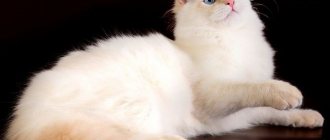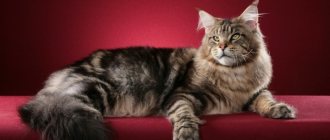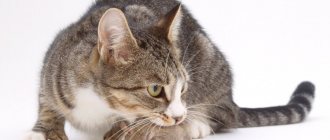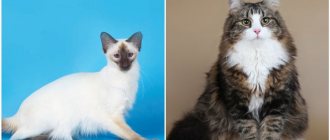Origin story
Many people want to have an obedient and affectionate predator at home.
But getting it is not so easy: life in the wild leaves a significant imprint on both the individuals themselves and their offspring. The first attempt to breed such an animal was, at first glance, successful: the resulting breed called Savannah, unusually beautiful and with good physical characteristics, gained wild popularity. But over time, significant problems emerged: in the first generation bred, the males turned out to be infertile, and the subsequent ones gradually lost their resemblance to predatory cats.
The second attempt of the American Karen Sauzman turned out to be more successful: the breeder crossed a domestic purebred cat with... a domestic purebred cat. Naturally, the animals that were selected for work underwent the strictest selection, since they had to be as similar as possible to servals (eye shape, size of ears and body, length of limbs, color). The Abyssinian and Maine Coon breeds were used, among others.
The first representative of the Serengeti breed was presented to the general public in 1994. Her beauty was recognized everywhere, but official status to date has been issued only by one international association - TICA. But the work to improve the breed does not stop and the breed has every chance to take a high place in the general ranking of popular breeds in the world.
The breeder gave the name “Serengeti” to the breed in honor of the reserve in Tanzania.
Standards
Externally, the Serengeti is very reminiscent of servals: both in body and in stature. Males weigh a lot - 13-15 kg, females are significantly less than 8-10 kg.
| Standard | Description |
| Head | Small but graceful, elongated wedge-shaped. The chin is clearly defined, the cheekbones are smoothed, the cheeks are almost invisible. The nose is small and has a black edging along the edge. |
| Neck | Quite long, muscular, slightly wider towards the body. |
| Eyes | Round, large, the iris is green or yellow. |
| Ears | Wide, located close to each other. Their tips are rounded. The deep auricle is slightly pubescent inside. |
| Torso | Long, strong, with a straight back line and strong bones. |
| Limbs | Slender, paws oval and large. |
| Tail | Dense, its length can be any, but preferably up to the animal’s shoulder. It is dense at the base, the tip is narrow and, according to the standard, should be painted black. |
| Wool | The coat is thick and dense, silky to the touch, with a characteristic “diamond” shine. Guard hairs are clearly visible. |
The generally recognized disadvantages are:
- a stocky body, as if “bent” to the ground;
- short limbs;
- small ears;
- massive bones;
- two-color spots, shaped like rosettes, and spots that turn into stripes on the sides;
- blue iris;
- white spots on the body;
- white socks on the paws and a white tip of the tail.
Description of the breed
Representatives of the breed are visually similar to servals, but they have nothing in common in the set of chromosomes. Serengeti cats have the following characteristics:
- Kittens have a flat, wedge-shaped head. The chin is pronounced, but not massive. The cheeks are not clearly defined.
- The ears attract special attention. They appear alert, high-set and large. The canonical size of the ears should be equal to half the animal's head.
- The eyes are set wide. They are round, very large and have a beautiful honey color. According to the standard, eyes can also be light green or hazel in color.
- Cats have a wide nose, with a dark nose and long whiskers.
- The neck is elongated, widening from the head to the shoulders.
- Already in the first weeks after birth, babies begin to show the distinctive qualities of the breed - muscularity and grace.
- The ideal representative of the breed has medium dimensions. Moreover, males are much larger than females.
- The limbs are powerful, strong and long.
- The tail of the Serengeti is never very long, but it is often impressively thick. The tip of the tail is always black.
- Females weigh 8-12 kg, males can reach 15 kg.
- A noticeable difference between representatives of this breed and other cats is the lack of undercoat. In addition, they do not have pants or manes. The wool is very thin, soft, short and incredibly pleasant to the touch.
- Cats can come in several colors: black, spotted black tabby, gray or smoky.
- The spots should have a round shape and be slightly elongated horizontally.
- A distinctive feature is the presence of a dark path near the inner eye area.
Colors
Colors recognized by the standard:
- Black.
- Smokey (with marks).
- Tabby is black.
- Tabby brown.
- Tabby silver.
In the photo of a Serengeti cat of popular colors,
the lower abdomen and chin must be light, and there should always be a pattern in the form of a fingerprint on the outside of the ears.
Price
It is not easy to purchase an experimental breed kitten in our country. It is better to look for a true representative of the Serengeti in America, in the reliable nursery of Karen Southman, the ancestor of the species. Not counting transportation costs, a rare pet will cost 40-150 thousand rubles. The price of the Serengeti in the USA varies from 500 to 3000 dollars, depending on important factors:
- origin of the kitten;
- age of the animal;
- health conditions;
- color features;
- reputation of the nursery;
- acquisition purposes.
Private breeders sometimes sell kittens from unions of Serengeti and Oriental or Bengal cats. The cost of such kittens is lower and it is easier to buy them. Many people choose a Serengeti kitten in the photo provided by the breeder before purchasing, but after visiting the nursery, they leave with another animal.
Personal contact and communication are very important in order to understand which baby will seem the most attractive, “one of our own.” For buyers who plan to breed a breed, choosing a kitten is more difficult. Preliminary preparation and knowledge of professional intricacies are required.
Character and behavior
The Serengeti give the impression of dangerous predators, agile, fast and bloodthirsty. But first impressions are deceiving. In fact, these cats are charm itself. They love people very much and become attached to the family in which they grow up, and for them the leader is both authority and best friend.
The Serengeti do not like to be alone and do not like to lie idle: both of these points can cause you a lot of trouble. Leaving the Serengeti alone for a long time is fraught with complete destruction of its home, the same awaits you if you forget to provide your pet with enough entertainment.
Toys alone will not be enough for him: active cats definitely need their own play complex with shelves at different heights, pipes and ladders. Therefore, breeders strongly do not recommend keeping a Serengeti in a small apartment filled with furniture - this cat needs space! A private house with a large garden in which the cat can run and jump to its heart’s content is what she needs. The Serengeti should have a lot of walks, as well as physical activity, otherwise the furnishings of your home may suffer greatly.
Serengetis have excellent spatial awareness and are not inclined to wander far from home, so you can safely let them walk around the garden alone. And, considering that the Serengeti will not go into the hands of a stranger at any price and will be able to stand up for itself, you don’t have to be afraid that the animal will be stolen.
After walking around the neighborhood, your pet may bring home guests: other cats.
Serengeti cats are persistent and extremely stubborn. If they get something into their head, they will pursue it with all their ardor, and you will have to make a lot of efforts to stop them. The education of these cats should begin literally from the moment they open their eyes.
If you treat the Serengeti poorly, he will become irritable and extremely aggressive.
Their leadership habits are unlikely to allow you to have an equally independent cat or large dog at home. Having sensed a rival, the Serengeti will not calm down until it shows who is in charge. And if his opponent is as fearless as he is, fights cannot be avoided. Moreover, the Serengeti is not afraid of either cats or dogs. If he thinks that his owner is in danger, he will rush into battle without hesitation. With this cat you will not be able to have either a bird or a small rodent: their hunting instinct is fully developed.
What does this pose mean in cats: crouching to the ground, arching their back, starting a mournful song?
Mating gamesPreparing for a fight
Seregneti are still chatterboxes. The collection of sounds that they can reproduce knows no bounds: they can not only meow and purr, but also grumble, grumble, coo, yelp, growl, roar and much more. You will hear the sonorous voice of your pet from morning to evening: the Serengeti will not miss the opportunity to comment on your actions, tell you about his thoughts and, in general, chat about all sorts of trifles.
It is not easy to buy a Serengeti cat: this breed is new and still has the status of experimental. There are no nurseries in Russia and neighboring countries. If you have the opportunity, buy a kitten in the UK or America: there are nurseries there that raise strong and healthy animals that meet all standard requirements. Such a purchase will cost a tidy sum: the price tag starts from 40,000 rubles and reaches 150,000 rubles. Not only the color and place of purchase matters (you will have to pay for transportation from the States separately), but also the purity of the blood: the 4th generation individuals will be the most expensive.
They are not afraid of loud sounds and transport, so they can be fearlessly transported in any transport, be it an airplane, a train or a car. But always use a leash!
Choose a kitten that is brave and active, with a good appetite and visually healthy (with clean ears, eyes and butt, shiny fur). The age for moving to a new home is 3.5-4 months. By this time, the kids have already received their first vaccinations, have learned to eat and go to the litter box on their own, if not, we have an article on how to train a kitten to use the litter box.
Nutrition
To the delight of owners, Serengeti cats are not prone to gluttony. Moderate appetite helps maintain health and longevity of pets. The optimal feeding schedule is morning and evening. Kittens and pregnant cats are fed more often - up to 4 times a day. The owner needs to immediately make a choice about what diet his pet will have - from natural products or from ready-made food.
Veterinarians and experienced breeders recommend the second option. Professional food is developed by specialists; it contains more nutrients and microelements than natural food. Owners save time preparing food for their pets. You need to choose dry and wet food from the super premium series, premium class for large cats.
If the choice is made in favor of foods, it is important to ensure a balanced diet. At least 60% of the feed should be in the form of meat (beef and veal only). You can add chicken, dairy products, cereals, vegetables, eggs. You cannot include dishes from a person’s table that include salt, sugar, spices, or food additives.
Smoked, fried and flour products are prohibited. Feeding fish leads to urolithiasis. On the recommendation of a veterinarian, vitamin components should be added. Pedigree pets need to prepare food separately. To prevent dental problems, it is sometimes useful to offer to chew cartilage and dry food, but not bones, which are dangerous to the health of pets.
Clean water should always be available. The drinking regime is especially important for the digestion of cats consuming dry food. Older cats sometimes suffer from kidney and bladder diseases. The emergence of health problems leads to dietary adjustments on the recommendation of a veterinarian.
Care instructions
Wool
The thick, short fur of cats of this breed has a great advantage over long-haired cats: it does not get tangled, does not get tangled, and does not leave an unpleasant residue on carpets and furniture.
She doesn’t need a slicker brush, but from time to time it wouldn’t hurt to scratch the animal with a brush with rubber or silicone teeth. This procedure will remove excess hair and activate blood circulation. Frequency - once every 2 weeks.
Bathing
The Serengiti have nothing against swimming: among their ancestors there are individuals who can swim. But you shouldn’t wash them too often, so as not to wash off the protective film from the skin once again. This can lead to irritation and dermatitis.
Expert opinion
Dusheba Vera Ivanovna
In 2010, she graduated from the Moscow State Academy of Veterinary Medicine named after K.I. Scriabin with honors, specializing in veterinary medicine. I regularly attend veterinary conferences, congresses, and webinars.
Use only a special detergent for animals. Our usual human lotions and shampoos are not suitable: they contain many components that can not only cause an allergic reaction, but also poison your pet.
Claws
The Serengeti successfully grinds down its claws while playing in nature. If the cat does not walk in the garden and does not have the opportunity to climb trees, buy her several durable scratching posts and install them in different rooms of the house. Accustom your kitten to them from an early age, otherwise, as he grows up, the animal will not think twice about it, but will begin to sharpen its claws in any place convenient for it.
Eyes
The eyes of these cats rarely cause concern. The Serengeti retains visual acuity until old age and almost never suffers from conjunctivitis and inflammation. If you notice that discharge has begun to accumulate in the corners of your eyes, try wiping them with a cotton pad soaked in eye lotion, boric acid or boiled water. If the discharge is abundant, thick, green or brown in color and smells unpleasant, you should take your pet to the veterinarian.
Ears
You don't need any special care for your ears either: remove excess wax once a week and make sure that no liquid gets inside (during bathing, for example).
Teeth
It’s worth saying something special about teeth. If your pet eats soft wet food, minced meat and ground food, his teeth will soon be covered with plaque, and then it’s not far from tartar. Therefore, you need to get your cat used to brushing its teeth weekly.
Buy cat toothpaste (human toothpaste will not work: since animals do not know how to spit, they only swallow, fluoride and other components will only harm them), secure the cat between your knees, and brush your teeth with soft, gentle movements from bottom to top for one minute.
If a cat prefers raw meat and vegetables, its teeth will be cleaned automatically, but even in this case, regular brushing is necessary. But not so often: it is enough to brush once a month, and once a year take the animal to the dentist for ultrasonic cleaning.
Expert opinion
Dusheba Vera Ivanovna
In 2010, she graduated from the Moscow State Academy of Veterinary Medicine named after K.I. Scriabin with honors, specializing in veterinary medicine. I regularly attend veterinary conferences, congresses, and webinars.
Now on sale there are special treats for cleaning teeth in the form of pads and rings that cleverly remove plaque. Offer them to your pet a couple of times a week and additionally drip cleansing gel into the drinking water - this will be quite enough to prevent oral diseases.
Keeping a pet
A large cat cannot live in a cramped apartment; it needs a lot of free space. The ideal place to keep it is a private house with its own yard. It is advisable that the area be fenced with a high fence, then the pet can be released outside. To prevent the pet from jumping over the fence, a special pinwheel is installed on it, which does not allow it to grab the edge of the fence.
Face of a Serengeti cat from the front
Before moving a kitten in, you should remove expensive items from the shelves and generally make the home safer for the little prankster. What you will need to own a Serengeti cat:
- large tray - take it for growth, as the pet will become large;
- scoop, filler;
- cat complex (preferably multi-level with a running wheel);
- spacious bed;
- scratching post;
- a lot of toys;
- harness;
- carrying;
- shampoo;
- dental care products;
- nail clipper;
- massage mitten for combing wool.
Hygiene
Caring for a domestic Serval is not burdensome - the cat needs to be brushed once a week, and more often during shedding. You can bathe your pet, but not more than once a month. It is important to accustom a kitten to water from an early age so that in the future this procedure does not cause fear, because coping with a large animal in the bath will not be easy.
Serengeti kitten plays
Ears need to be cleaned of greasy deposits once a week. To do this, use a cotton pad and a special lotion. Oral hygiene will help prevent gingitis. Clean your cat's teeth with a brush and pet toothpaste every 7 days. To prevent the formation of tartar, introduce solid granulated food into the diet.
Nails need to be shortened twice a month. Use a nail clipper, not scissors. Carefully remove the tip by 1 or 1.5 mm so as not to injure the tissue with blood vessels.
Attention! Serengeti cats are noble and clean. They don't like going into a dirty litter box. Try to clean the toilet after each visit.
Caring for a domestic Serval also includes health care. Once a year, it is recommended to undergo a preventive examination by a veterinarian and get vaccinations. Cats that have the opportunity to walk are regularly treated for fleas and worms.
Feeding: recommendations for creating a diet
Noble representatives of the Serengeti breed should be fed with ready-made super-premium or holistic dry formulas. They are well saturated and contain various vitamins, minerals and amino acids. Since these are large animals, they need to receive approximately one and a half times more calories than representatives of other breeds.
Attention! An adult pet should be fed 2 times a day at the same time, and kittens, depending on age, from 3 to 5 times a day.
Among the owners of purebred cats, there are those who prefer to prepare their diet from natural products. In this case, 70–80% of the total food volume should be meat and offal. Choose low-fat varieties - poultry fillet, beef tenderloin, veal, rabbit. Heart and stomachs can be given 2 times a week.
Lean meat is suitable for cats
The remaining 20% of the diet is supplements, such as cereals, vegetables, eggs, and dairy products. You can treat your pet to a piece of cheese, shrimp, fish, and liver once a week. It is forbidden to feed cats fried, spicy, salty foods, sweets, bones, mushrooms, beans, and bread. Don't give bones or whole milk.
Catering
A balanced diet is the key to your pet’s health and good mood. Therefore, decide as quickly as possible what you will feed him: industrial feed or natural food?
It is not recommended to combine one with the other, just as it is not recommended to jump alternately to one or the other.
Natural products
Natural food must be of high quality and fresh, prepared according to the recommendations of veterinarians. The menu should include the following products:
- Meat: veal, beef, rabbit, lamb, poultry (chicken, quail, turkey). It is given raw (after freezing) or boiled (the latter option is worse, since cooking destroys a number of vitamins).
- Porridge: rice, oatmeal, pearl barley, millet, buckwheat, semolina. The porridge is cooked in water (only semolina for babies - in milk), without adding anything other than half a teaspoon of vegetable oil (olive, sunflower, flaxseed).
- Dairy products: yogurt, fermented baked milk, sour cream, low-fat cottage cheese, bio-yogurt.
- Vegetables: zucchini, carrots, pumpkin, asparagus, broccoli. Allows greens: green salad, dill, parsley. Vegetables can be given raw, but most often cats turn their nose up at raw ones. Therefore, stew them or boil them, chop them finely and mix with porridge and meat, add to meatballs and cutlets.
- As a treat, cats can be given a cucumber, apple, pear, watermelon or melon to chew on.
It is better not to give fish to cats of the Serengeti breed: due to kidney problems in representatives of this breed.
Your cat should always have clean water in a separate bowl. You cannot give your animal liquid from the tap: tap water can be too hard or saturated with chlorine, and contains an admixture of salts and other components that are dangerous for cats. Leave the water in a container without a lid for 10-12 hours, buy purified water in a store or pass it through a household filter.
Recommended food
If you choose ready-made food, remember: you should only buy food from the holistic and super-premium classes. They are made from high-quality products (meat, fish, vegetables, berries, fruits) in compliance with all necessary standards, they retain the maximum amount of vitamins and nutrients. Wildcat, Akana, Kanagan, etc.
Premium and, especially, economy food, despite loud advertising slogans, is of much worse quality. Instead of pure meat, they use meat waste (and since there is no decoding on the packaging, this can mean anything), artificial preservatives, unsafe dyes, flavor enhancers, but there are practically no useful components there.
Below are recommended super-premium foods. Links with the names of the food are clickable, on them you can, within our website, get acquainted with the descriptions of the food and read reviews from owners of Serengeti cats.
| Holistic | Super premium | Super premium |
| Wildcat | Trainer | Husse |
Animal character
The Serengeti is a very talkative cat. The animal can follow its owner for hours and purr something. Sometimes this talkativeness is excessively tiring, but you definitely won’t be able to force your pet to remain silent. The Serengeti are stubborn and freedom-loving. They love to play, so they need to be provided with plenty of toys.
Owners note the fearlessness of their pets. Neither large yard dogs nor sharp sounds scare them. The Serengeti has a fighting nature and should not be let out for a walk alone. In the house, representatives of this breed behave like leaders. But if a cat sees that it is treated with respect, it begins to show kindness and tenderness.
Diseases
The Serengiti is a strong breed in itself and lives for 12-15 years, but a lot depends on the conditions in which you will keep it. They have a certain tendency to form stones and in general: their genitourinary system is their only weak point. Moreover, males, rather than females, begin to suffer from this disease earlier and more often. Symptoms: the animal often runs to the toilet, but it is clearly painful for him to urinate. It sits “on the potty” for a long time, drops or blood clots are noticeable in the urine. Reason: hypothermia, trauma, improper feeding (excess fish in the diet or lack of water). Don't put off visiting your doctor!
Deworming and vaccination should be carried out regularly, even if your cat only walks indoors. Parasites can easily enter his body through raw meat or water, and you can bring home pathogens of such dangerous diseases as rabies or panleukopenia on your own street shoes or hands.
Stroke the cat with unwashed hands and voila! — as soon as she licks her fur, the pathogens will begin their attack.
Castration and sterilization are a common condition of sale. The operation is carried out no earlier than 7-9 months, when the process of puberty has not yet come to an end, and the body can already endure such a serious procedure. In females, this is best done immediately after the first heat. During the operation, anesthesia and self-absorbing sutures are used.
If you want to castrate an adult animal, remember: your pet, most likely, even after the operation, will retain the habit of shouting in a bad bass voice at the appropriate time and pedantically marking corners. So it’s better not to put off your plans.
If you dream of getting offspring, wait until your cat reaches the age of 1 year: by this time she will have already gone through 2-3 heats and her hormonal levels will have stabilized. The same deadline is set for cats. A cat that gives birth more than 2 times in 3 years quickly gets tired, begins to get sick and dies early. During pregnancy, a cat gives birth to from 3 to 8 kittens. A partner should be chosen carefully, studying documents and pedigree, and preferably an experienced one. Professionals breed Serengiti cats with Oriental cats and Bengals.
Health status
Serengeti are prone to developing urolithiasis, so their health must be closely monitored. It is worth knowing that this disease occurs more often in females than in males. It is almost impossible to see the first signs of pathology. The disease begins to appear suddenly:
- the cat cannot go to the toilet for a long time;
- meows anxiously and licks the opening of the urethra;
- begins to urinate in places not intended for this purpose.
Under no circumstances should you self-medicate; you should urgently take the animal to the veterinarian. The doctor will tell you what to do and recommend what is best to feed your cat to avoid negative consequences. Predisposition to urolithiasis is the only possible problem in these cats . Otherwise they are in very good health.
Breeders need to be aware that crossing the Serengeti with wild cats and servals is unacceptable. The kittens that are born will not resemble the representatives of this breed or will be infertile. The lifespan of the Serengeti is about 10 years.
Advantages and disadvantages
- Friendly.
- Affectionate.
- They quickly find a language with other pets.
- They don't take revenge.
- They don't remember insults.
- Clean.
- Beautiful in appearance.
- They have good health.
- Attached to home and people.
- Temperament inexcitable.
- They are expensive.
- There are few nurseries.
- They don't like to be alone.
- You can feed them only with selected feed and the best products.
- They cannot live in a small apartment.
- Excessive curiosity and activity can be tiring.
- Chatty.
Personality of Serengeti cats
Unlike their wild “twins” the Servals, the Serengeti are friendly and open to communication. They quickly become attached to their owner and follow him around the house relentlessly. If you deprive your cat of attention, she will persistently beg for it, trying in every possible way to make herself known: rubbing herself, laying on the keyboard, resting on her legs and resorting to other tricks.
The Serengeti does not tolerate being left alone for long periods of time. Rough treatment is alien to them. If they are treated poorly, they will grow into an aggressive and embittered animal.
Serengeti are intellectuals by birth, which, along with their stubbornness, causes a lot of trouble. If they are planning to do something, no prohibitions will stop them - they will find a way to do it their own way. They should not be spoiled too much, because in this regard cats are insatiable and begin to become impudent.
Serengeti are extremely inquisitive and active, easy to train
They are leaders by nature, so they get along with other pets only if they recognize them as a commander. They will desperately defend their championship until they achieve what they want. They are fearless and will not shy away even from a large dog. They are ready to be the first to fight when their owner is in danger.
They cannot remain calm for a long time; they constantly find active activities. Their playfulness and perkiness benefit children. You will never get bored with such a pet. Any object turns into a toy for them.
Favourite cat
The house must have special structures for cats to climb and jump on.
Photo gallery
Below are photos of Serengeti cats.










